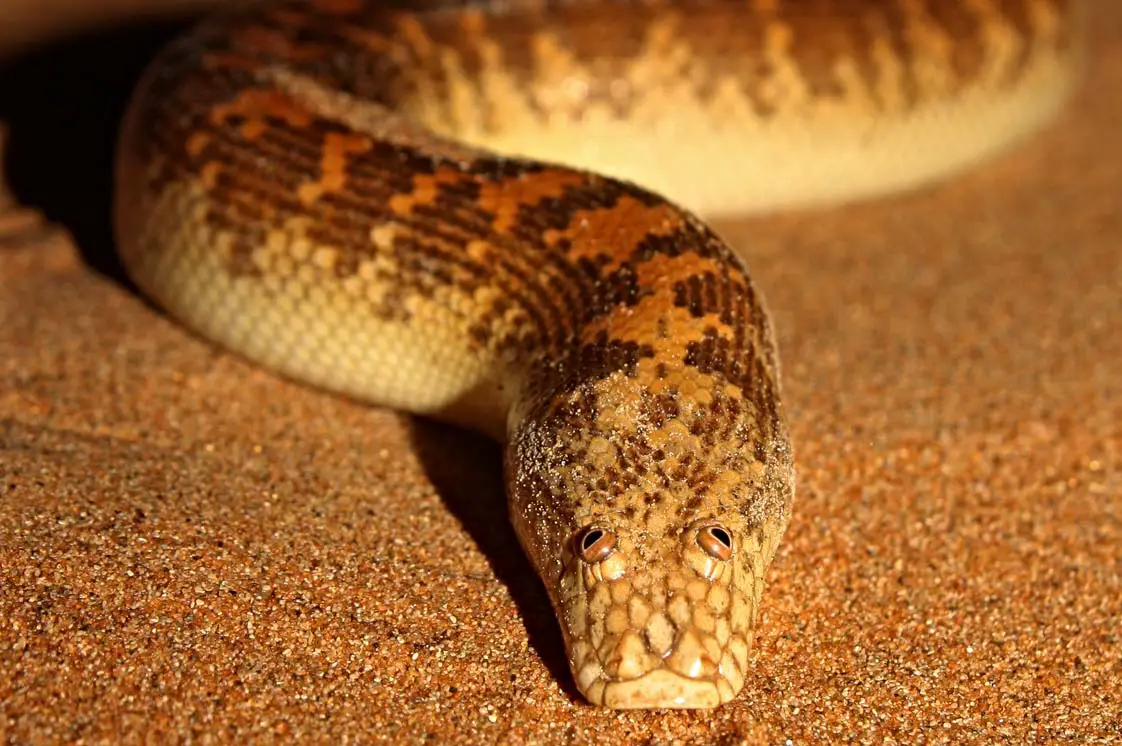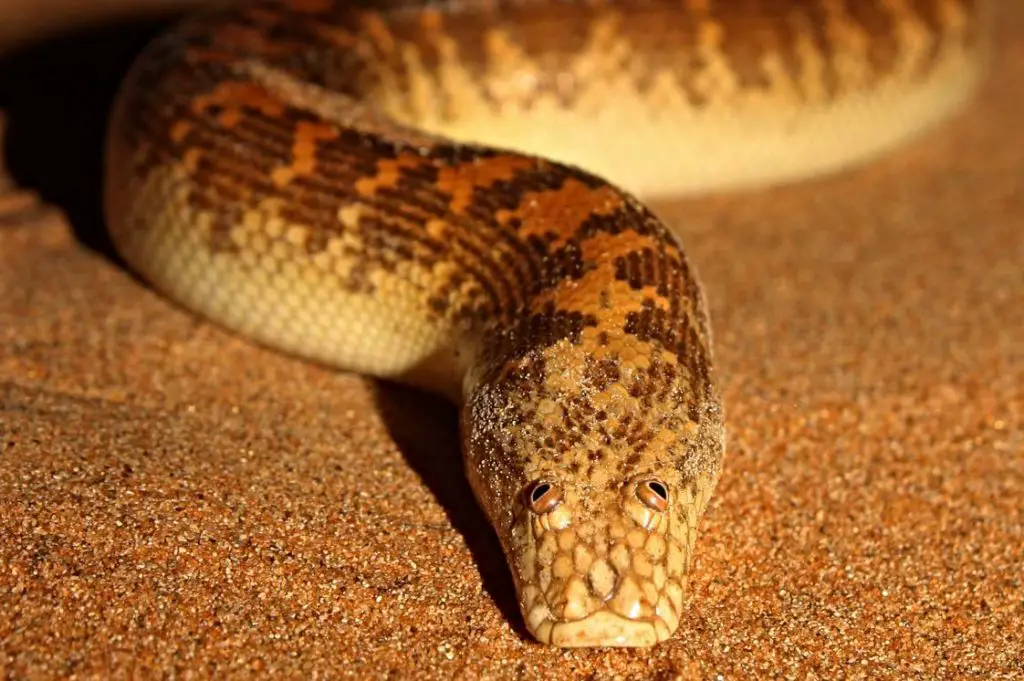Looking for a unique and exotic pet? Have you considered an Arabian sand boa? These small serpents are native to the deserts of the Arabian Peninsula and make for fascinating pets. But before you make your decision, it’s important to know the ins and outs of owning an Arabian sand boa.
From their size and temperament to their diet and habitat requirements, there are many factors to consider when deciding if an Arabian sand boa is the right pet for you. In this article, we’ll explore the pros and cons of owning an Arabian sand boa and provide you with all the information you need to make an informed decision. So, let’s dive in and discover if these slithering creatures are the perfect addition to your household.
Yes, Arabian Sand Boas can make good pets for experienced reptile owners. They are relatively small and easy to care for, but can be skittish and defensive if not handled properly. They require a warm and dry habitat with a hide box and a proper diet of mice or rats. It is important to research and understand their specific needs before considering them as pets.

Are Arabian Sand Boas Good Pets?
If you are looking for a unique pet, the Arabian sand boa might be a great option for you. With their small size and low maintenance needs, they are becoming increasingly popular among reptile enthusiasts. However, before deciding to adopt an Arabian sand boa, it is important to understand their care requirements and whether they are a good fit for your lifestyle.
Appearance and Behavior
Arabian sand boas are small snakes, typically growing to be around two feet in length. They have a distinctive appearance with sandy brown and cream-colored scales. These snakes are known for their docile temperament and are not aggressive towards humans. They are also nocturnal, so they are most active during the night.
When it comes to handling, Arabian sand boas are generally easy to care for and do not require a lot of attention. However, they may become stressed if handled too often or too roughly. It is recommended to handle them no more than once a week to keep them comfortable and healthy.
Enclosure and Environment
When it comes to creating an enclosure for your Arabian sand boa, it is important to mimic their natural environment as much as possible. They are native to the deserts of the Middle East, so they require a dry and warm habitat. A 20-gallon tank with a screened lid is typically sufficient for one snake.
Make sure to provide a heat source, such as an under-tank heating pad or ceramic heat emitter, to maintain a temperature range of 80-90°F. Arabian sand boas also require a humidity level of 40-50%. You can achieve this by misting their enclosure once a day and providing a water dish for them to soak in.
Diet and Feeding
Arabian sand boas are carnivorous and primarily eat small rodents, such as mice and rats. It is important to provide them with an appropriately sized prey item every 7-10 days. In the wild, they may go weeks or even months without eating, so they are able to handle longer periods between meals.
When feeding your Arabian sand boa, it is important to never handle them right after a meal as this can cause regurgitation. It is also recommended to feed them in a separate container to avoid accidentally ingesting substrate or other debris.
Benefits of Owning an Arabian Sand Boa
One of the main benefits of owning an Arabian sand boa is their low maintenance needs. They require minimal attention and can be left alone for longer periods of time, making them a great option for busy owners. They are also relatively small and do not require a lot of space, making them a good choice for apartment dwellers.
Additionally, Arabian sand boas have a long lifespan, with some living up to 20 years in captivity. They are also generally healthy and do not require frequent vet visits unless a problem arises.
Drawbacks of Owning an Arabian Sand Boa
While Arabian sand boas can make great pets, there are some drawbacks to consider. For one, they are not a social species and do not enjoy being handled frequently. They also require a specific environment to thrive, which can be expensive to set up initially.
Another potential drawback is their diet, as feeding them live prey items can be unsettling for some owners. Additionally, some people may be uncomfortable with the idea of having a snake as a pet.
Arabian Sand Boas vs. Other Snake Species
Compared to other snake species, Arabian sand boas are generally easy to care for and have low maintenance needs. They are also smaller and require less space, making them a good option for owners with limited space.
However, other snake species may be more social and enjoy being handled or interacted with more frequently. Additionally, some snake species may have more unique or striking appearances, which can be a deciding factor for some owners.
Conclusion
Overall, Arabian sand boas can make great pets for the right owner. They are easy to care for, have a long lifespan, and do not require a lot of attention. However, it is important to understand their specific care requirements and whether they are a good fit for your lifestyle before adopting one. If you are considering an Arabian sand boa as a pet, make sure to do your research and consult with a reptile expert to ensure that you can provide them with a happy and healthy home.
Frequently Asked Questions
Arabian sand boas are a type of snake that is commonly found in the deserts of the Middle East. They are known for their unique appearance and docile nature, which makes them a popular choice among reptile enthusiasts. If you are considering getting an Arabian sand boa as a pet, here are some answers to frequently asked questions that may help you make an informed decision.
Are Arabian Sand Boas Good Pets?
Arabian sand boas can make great pets for the right person. They are relatively easy to care for and are generally docile and calm. However, they are not the best choice for everyone. If you are looking for a snake that you can handle and interact with regularly, an Arabian sand boa may not be the best choice. While they can be handled, they are not particularly social animals and may become stressed or agitated if handled too often.
In addition, it is important to note that Arabian sand boas are not the most active snakes. They are primarily nocturnal and spend most of their time hiding and burrowing. This means that they may not be the best choice for someone who is looking for a snake that is active and constantly on the move. However, if you are looking for a unique and interesting pet that is relatively low-maintenance, an Arabian sand boa may be a good choice for you.
What Do Arabian Sand Boas Eat?
Arabian sand boas are carnivorous and primarily eat small rodents such as mice and rats. They are also known to eat other small animals such as lizards and birds. In captivity, it is important to provide your snake with a diet that is both nutritious and appropriate for their size. It is recommended that you feed your Arabian sand boa once every 1-2 weeks, depending on their age and size.
It is also important to note that some snakes may be picky eaters and may refuse to eat certain types of food. If you are having trouble getting your Arabian sand boa to eat, it is best to consult with a veterinarian or experienced reptile keeper to ensure that your snake is getting the proper nutrition.
How Big Do Arabian Sand Boas Get?
Arabian sand boas are a relatively small species of snake, with adults typically reaching a length of 2-3 feet. However, some individuals may grow larger or smaller depending on a variety of factors such as genetics and diet. It is important to provide your snake with an appropriate enclosure that is large enough for them to move around comfortably.
In addition, it is important to note that Arabian sand boas are burrowing snakes and will require an enclosure that allows them to dig and burrow. This means that a shallow enclosure with minimal substrate may not be suitable for this species.
What Kind of Enclosure Do Arabian Sand Boas Need?
Arabian sand boas require an enclosure that is both secure and appropriately sized. A glass terrarium or plastic enclosure with a secure lid is recommended. The enclosure should be large enough to allow your snake to move around comfortably and should include plenty of hiding spots and substrate for burrowing.
It is also important to maintain proper temperature and humidity levels within the enclosure. The temperature should be kept between 80-85 degrees Fahrenheit during the day and no lower than 70 degrees Fahrenheit at night. The humidity level should be kept between 40-60%, with occasional misting to ensure proper shedding.
Do Arabian Sand Boas Require Special Care?
Arabian sand boas are relatively low-maintenance snakes and do not require any special care beyond what is required for most reptiles. However, it is important to provide them with a suitable enclosure, proper nutrition, and appropriate temperature and humidity levels.
It is also important to handle your snake with care and to avoid any sudden movements or loud noises that may startle or stress them. Regular check-ups with a veterinarian who is experienced in caring for reptiles are also recommended to ensure that your snake remains healthy and happy.
Arabian Sand Boa – Animal of the Week
In conclusion, whether or not Arabian Sand Boas make good pets ultimately depends on your personal preferences and experience as a reptile owner. While they are generally low-maintenance and easy to care for, they may not be the best choice for first-time snake owners due to their shy and secretive nature.
If you are an experienced reptile owner looking for a unique and fascinating addition to your collection, the Arabian Sand Boa could be an excellent choice. They are beautiful creatures with unique adaptations for life in the desert, and their docile temperament makes them a joy to handle.
However, if you are looking for a more interactive and social pet, you may want to consider a different species of snake. Arabian Sand Boas are not known for their affectionate nature or willingness to interact with humans, so they may not be the best choice for those looking for a pet that enjoys human attention.
Overall, Arabian Sand Boas can make great pets for the right owner. If you are considering adding one to your collection, be sure to do your research and make an informed decision based on your own preferences and experience as a reptile owner.

